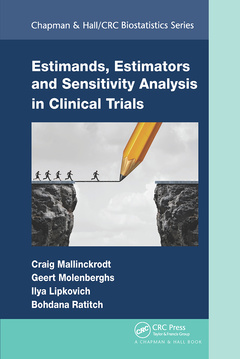Estimands, Estimators and Sensitivity Analysis in Clinical Trials Chapman & Hall/CRC Biostatistics Series
Auteurs : Mallinckrodt Craig, Molenberghs Geert, Lipkovich Ilya, Ratitch Bohdana

The concepts of estimands, analyses (estimators), and sensitivity are interrelated. Therefore, great need exists for an integrated approach to these topics. This book acts as a practical guide to developing and implementing statistical analysis plans by explaining fundamental concepts using accessible language, providing technical details, real-world examples, and SAS and R code to implement analyses. The updated ICH guideline raises new analytic and cross-functional challenges for statisticians. Gaps between different communities have come to surface, such as between causal inference and clinical trialists, as well as among clinicians, statisticians, and regulators when it comes to communicating decision-making objectives, assumptions, and interpretations of evidence.
This book lays out a path toward bridging some of these gaps. It offers
¿ A common language and unifying framework along with the technical details and practical guidance to help statisticians meet the challenges
¿ A thorough treatment of intercurrent events (ICEs), i.e., postrandomization events that confound interpretation of outcomes and five strategies for ICEs in ICH E9 (R1)
¿ Details on how estimands, integrated into a principled study development process, lay a foundation for coherent specification of trial design, conduct, and analysis needed to overcome the issues caused by ICEs:
¿ A perspective on the role of the intention-to-treat principle
¿ Examples and case studies from various areas
¿ Example code in SAS and R
¿ A connection with causal inference
¿ Implications and methods for analysis of longitudinal trials with missing data
Together, the authors have offered the readers their ample expertise in clinical trial design and analysis, from an industrial and academic perspective.
Section I Setting the Stage 1. Introduction 2. Why Are Estimands Important? Section II Estimands 3. Estimands and How to Define Them 4. Strategies for Dealing with Intercurrent Events 5. Examples from Actual Clinical Trials in Choosing and Specifying Estimands 6. Causal Inference and Estimands 7. Putting the Principles into Practice Section III Estimators and Sensitivity 8. Overview of Estimators 9. Modeling Considerations 10. Overview of Analyses for Composite Intercurrent Event Strategies 11. Overview of Analyses for Hypothetical Intercurrent Event Strategies 12. Overview of Analyses for Principal Stratification Intercurrent Event Strategies 13. Overview of Analyses for While-on-Treatment Intercurrent Event Strategies 14. Overview of Analyses for Treatment Policy Intercurrent Event Strategies 15. Missing Data 16. Sensitivity Analyses Section IV Technical Details on Selected Analyses 17. Example Data 18. Direct Maximum Likelihood 19. Multiple Imputation 20. Inverse Probability Weighted Generalized Estimated Equations 21. Doubly Robust Methods 22. Reference-Based Imputation 23. Delta Adjustment 24. Overview of Principal Stratification Methods Section V Case Studies: Detailed Analytic Examples 25. Analytic Case Study of Depression Clinical Trials 26. Analytic Case Study Based on the ACTG 175 HIV Trial
Geert Molenberghs is Professor of Biostatistics (Hasselt University, KULeuven. He works on surrogate endpoints, longitudinal and incomplete data, was Editor for Applied Statistics, Biometrics, Biostatistics, Wiley Probability & Statistics, and Wiley StatsRef and is Executive Editor of Biometrics. He was President of the International Biometric Society, is Fellow of the American Statistical Association, and received the Guy Medal in Bronze from the Royal Statistical Society. He has held visiting positions at the Harvard School of Public Health.
Ilya Lipkovich is a Sr. Research Advisor at Eli Lilly and Company. He is a Fellow of the American Statistical Association and published on subgroup identification in clinical data, analysis with missing data, and causal inference. He is a frequent presenter at conferences, a co-developer of subgroup identification methods, and a co-author of the book "Analyzing Longitudinal Clinical Trial Data. A Practical Guide."
Bohdana Ratitch is a Principal Research Scientist at Eli Lilly and Company. Bohdana has contributed to research and practical applications of methodologies for causal inference and missing data in clinical trials through active participation in a pharma industry working group, numerous publications, presentations, and co-authoring the book "Clinical Trials with Missing Data: A Guide for Practitioners".
Craig Mallinckrodt holds the rank of Distinguished Biostatistician at Biogen in Cambridge MA. He has extensive experience in all phases of clinical research. His methodology research focuses on longitudinal and incomplete data. He is Fellow of the American Statistical Association, has led several industry working groups on missing and longitudinal data, and received the Royal Statistical Society’s award for outstanding contribution to the pharmaceutical industry.
Date de parution : 12-2021
15.6x23.4 cm
Date de parution : 02-2020
15.6x23.4 cm
Thèmes d’Estimands, Estimators and Sensitivity Analysis in... :
Mots-clés :
LOCF Approach; Complier Average Causal Effect; likelihood based methods; NRC Report; time-to event methods; Ich E9; composite approaches; IPW Estimator; repeated measures; Full Data Likelihood; SAS; Intermittent Missing Data; R; MNAR Model; primary estimand; Missing Data; intercurrent events; Data Set; estimator's methodology; Imputation Model; clinical trials; IPW; sensitivity analysis; Principal Stratification; SAS Code; Post-baseline Visit; Missing Data Assumption; MAR Mechanism; Baseline Observation Carried Forward; Augmented Inverse Probability Weighted; Proc Sort Data; Clinical Practice; Average Causal Effect; MCAR Mechanism; CD4 Count; Proc Mi



